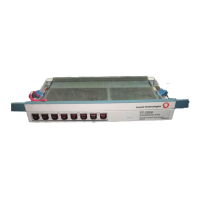Applications
2-24 Issue 8.0 July 2002
STS-1/STS-3Non-PreemptibleProtectionAccess2
This feature is available with FT-2000 OC-48 ADR Release 7.1 and later software.
More specifically, this feature is applicable for FT-2000 OC-48 ADR Terminal ring
configurations that are equipped with STS-1 granularity hardware (for example,
739 transmitter and 839B5 receiver) at all ring nodes.
NOTE:
For rings that are not equipped to support STS-1 granularity—then
non-preemptible protection access is supported at the STS-3 level. This
means that three STS-1 tributaries must be selected at a time. On a
comparative basis (STS-1 versus STS-3) it should be evident that the
STS-1 level gives the ability to use the available bandwidth more efficiently.
Bandwidth efficiency is even more important when mixing signals from
different services.
This feature permits the use of idle protection capacity to carry “extra traffic” on an
unprotected/non-preemptible basis. The traffic carried by non-preemptible
tributaries is not dropped (preempted) by any ring loopback protection switch. For
a two-fiber ring it is important to realize that whenever a protection tributary is
selected for non-preemptible protection access, the corresponding STS-3
tributary of service capacity on ALL spans of the ring becomes unprotected. This
results in two unprotected/non-preemptible tributaries on all spans of the ring;
both the service tributary (STS-3 #n) and the protection tributary (STS-3 #n+8).
NOTE:
The capability to select non-preemptible protection access on a per
individual span basis is made very useful in four-fiber rings by their ability to
provide per-span protection switching. Service on other spans can still be
protected. This gives four-fiber rings an advantage over two-fiber rings in all
applications where the need for non-preemptible capacity is to carry
add/drop traffic on individual spans, part-of-the-way around the ring.
In terms of user administration, there are two “protection access states”
associated with a tributary being used for Non-Preemptible Protection Access.
These two “protection access states” are:
■ Temporary, and
■ Permanent.
NOTE:
With these two additions there are now a total of three protection access
states (preemptible, temporary, and permanent).

